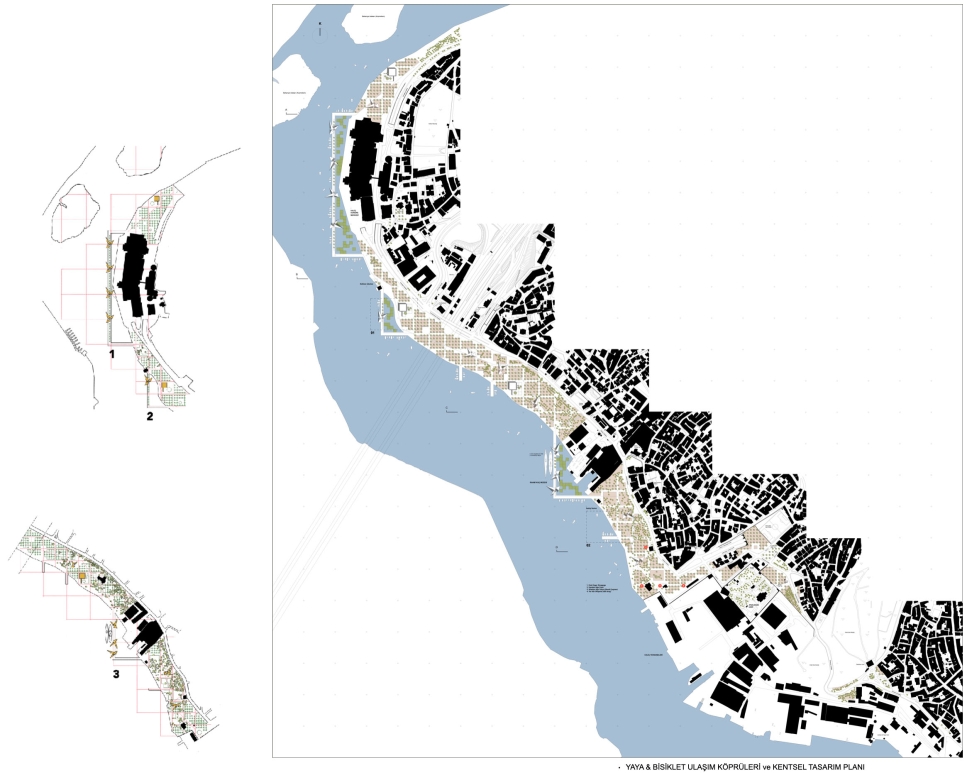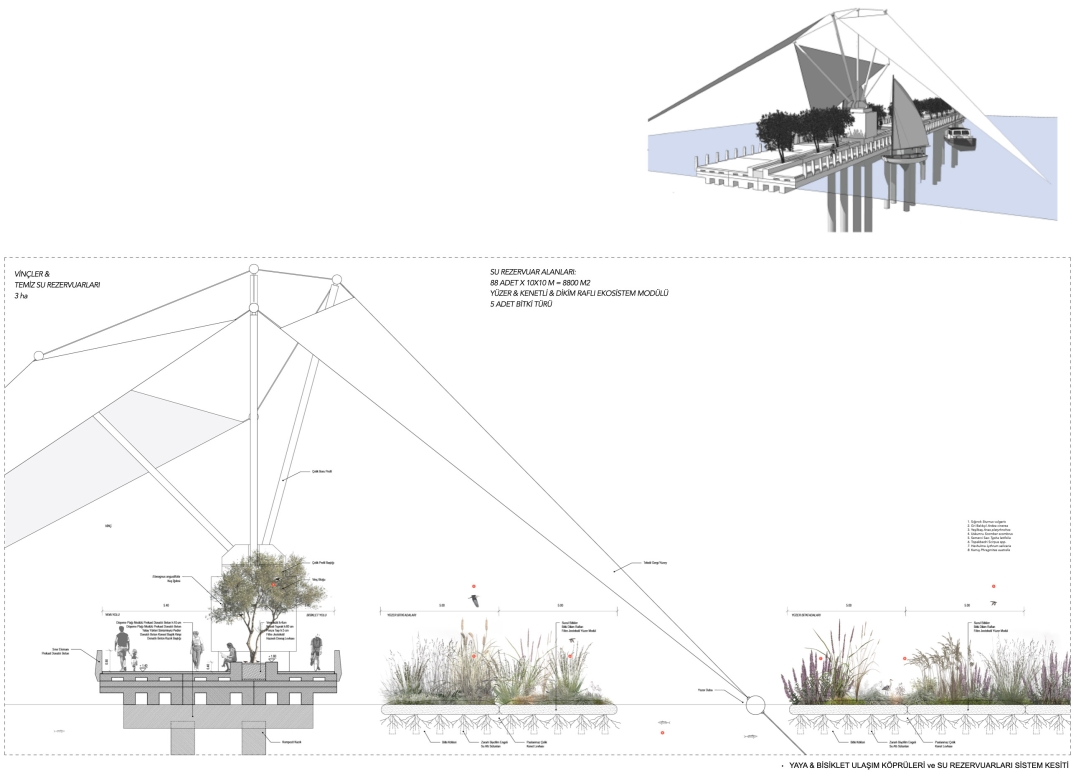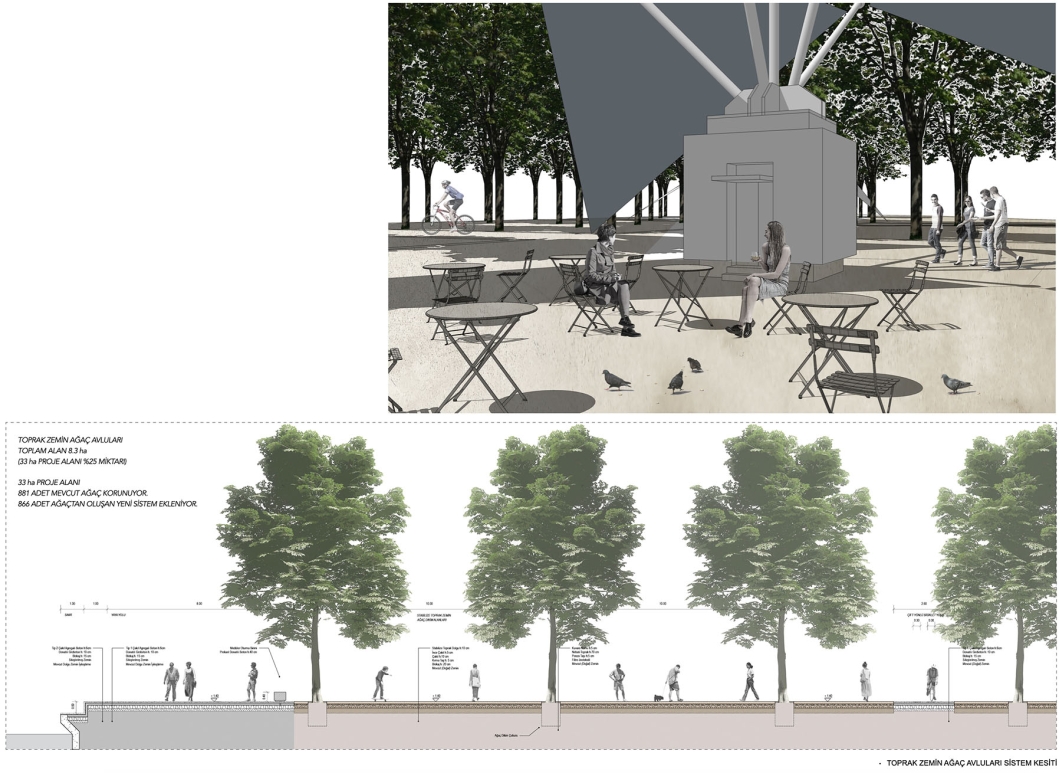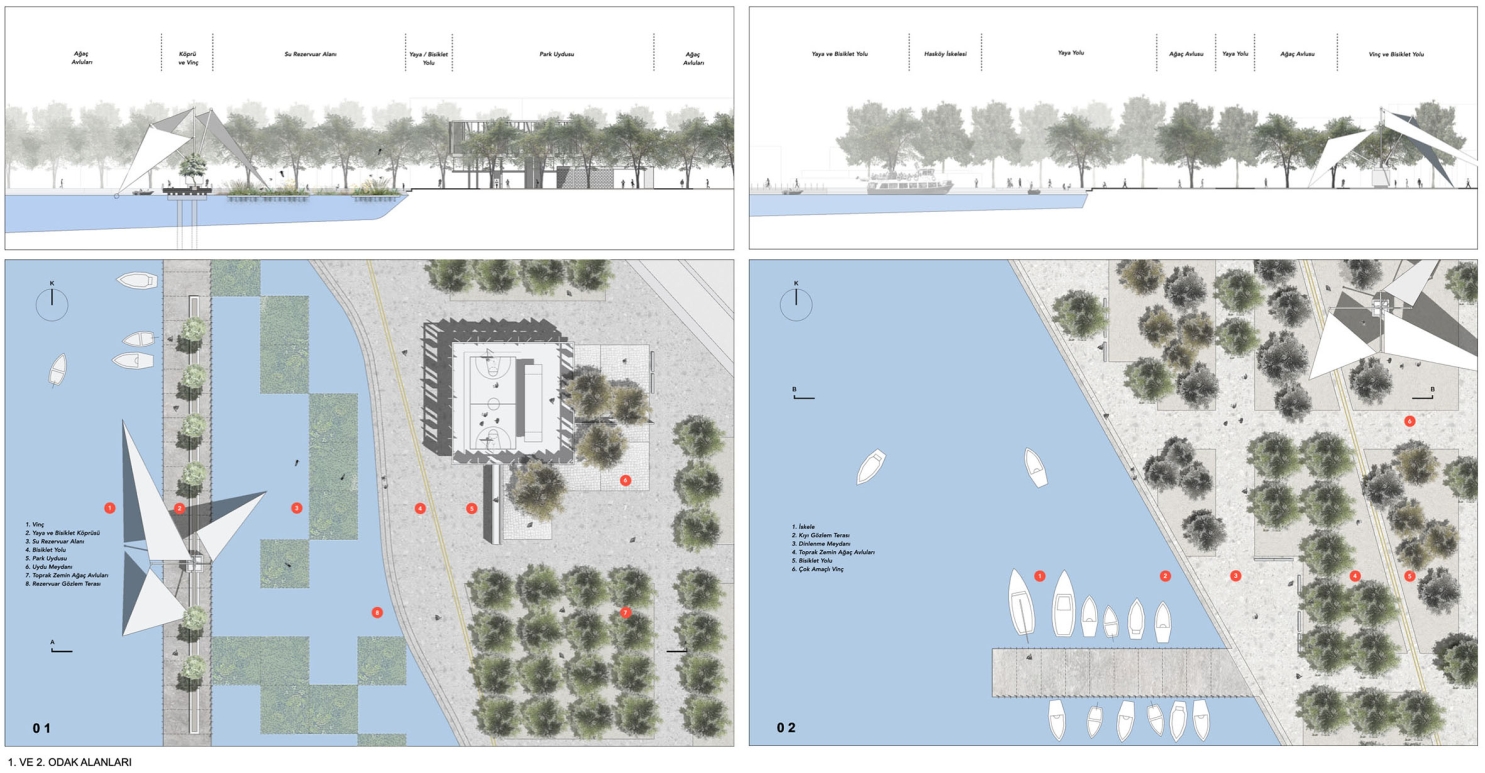K Ö P R Ü L E R , V İ N Ç L E R , A Ğ A Ç L A R , K U Ş L A R - H A L İ Ç
B R I D G E S , C R A N E S , T R E E S , B I R D S - G O L D E N H O R N
Portfolio Shortlisted Project Competition 2nd MENTION / 2. MANSİYON ÖDÜLÜ
City Park: Waterfront Park & Recreation + Bridge & Crane Structures as Landmarks + Ramned Earth Tree Courtyards + Biodiversity + Sports Squares + Social Engagements
+ 6th Region Northern Golden Horn, Hasköy, Istanbul TR + 33 ha
+ 2020 + Completed Project + Please swipe left for images.
+ Owner İstanbul Büyükşehir Belediyesi Istanbul Metropolitan Municipality
+ Collaboration + Hakan Tüzün Şengün PARCH
+ Coordination + Ahmet Topbaş ATTEC
The geographical area of the Golden Horn, where trade, public services, education services and recreation areas have been concentrated since the eighties, when it was cleaned, has very important potentials when considering its historical, archaeological, cultural and natural values.
As a result of the interventions made in this process, the relationship of the inhabitants of the Golden Horn with the coast remained well below its potential. The narrowing of open and green spaces, the scaleless recreation areas of the Golden Horn Region, which is one of the richest regions of Istanbul in terms of image elements, the loss of the continuity of pedestrian and bicycle movement, and the unqualified green texture are the most important problems of the area.
QUESTION (?)
Can a region loaded with extraordinary cultural, archaeological and natural values like the Golden Horn in Istanbul meet with a high-value urban park designed with advanced recreational opportunities and site-specific solutions - in a way that will make the highest contribution to the public interest?
Perhaps this is what needs to be done in the Golden Horn, especially for the correct and efficient use of resources for the public good.
To rethink the reflexes and potentials of public and especially green space use of Istanbul, which is a world capital, and to ensure that this gain is widely accessible by producing new resources and usage values with creative solutions. Istanbul, whose international value and values are unquestionably accepted, is a unique city of history, nature and archeology. In this sense, the shores of the Golden Horn offer us the possibilities of an urban green system that is open to producing very valuable potentials.
In this sense, the proposal of BRIDGES, CRANES, TREES, BIRDS, including the Golden Horn Congress Center in the north, is staged and layered with simple and low-cost solutions that prioritize the continuity of pedestrian and bicycle movement on the coastal band starting from the northern entrance of the center and extending to Shipyard Istanbul. It aims to establish a CITY PARK that produces relations and restores the relationship between the coast and the city.
CITY PARK is shaped around four main themes under the headings of BRIDGES, CRANES, TREES and BIRDS:
1. BRIDGES
The proposed pedestrian and bicycle bridges over the water establish the continuity of pedestrian movement between Tersane Istanbul and Haliç Congress Center in such a way that the bridges crossing the Golden Horn Congress Center and Rahmi Koç Museum along the shoreline achieve full pedestrian and bicycle continuity.
These two bridges, which primarily connect the citizens with the coast, enable the movement of both pedestrian and bicycle movements along the entire coast along the park and produce a new interface for small boat traffic and the use of the coast by the entire city. It proceeds in front of Haliç Congress Center in the direction of Bahariye Islands and connects Sütlüce Pier and Karaağaç Street as a two-band 450m pedestrian bridge.
The pedestrian movement, which is interrupted in both directions by the underground tunnel, especially on the coastal band, makes it possible to establish gradual and layered coastal views by establishing a buffer area between the filled area in front of the Golden Horn Congress Center and the public space on the coast, thanks to this pedestrian bridge link.
Bridges, which enrich the daily life activities associated with water and make uninterrupted use of the coast along the Sütlüce and Hasköy districts of the Northern Golden Horn region from the level of Bahariye Island, also function as a new shore connection for small boat traffic. The water areas between the existing coastline are designed as reserve water areas.
These special water areas consist of floating and dockable ecosystem modules where we will place specific plants and the unity life they provide. It is foreseen that the modules that make up the system will not be affected by the changes in the water level or wave conditions of the Golden Horn, as they are floating and are located in a limited area. Floating ecosystem modules, which are promising to restore the ecological functions of the Golden Horn water body, whose biological life values have been changed considerably by economic factors, will be able to offer an adaptive formation that can be integrated into the urban environment, which is established by humans but other living things manage life, for the future of the 3 reserve regions within the scope of the project.
In this sense, bridges uninterruptedly establish the continuity of pedestrian and bicycle movement at three different points, while enriching the life developed by the city park at the shoreline with the inner shore they produce.
2. CRANES
Cranes placed as support modules on bridges and in defined stabilized wood yards along the entire park shore; While producing flexibly configurable shaded spaces that define large spaces with white textile sails that scale the silhouette, they also produce multi-purpose volumes that can be used as bicycle stops, small cafes, spare parts and support units for cyclists, toilets or warehouses.
Cranes, these cubic units are completed with movable mechanical arms that can take different positions with steel profiles on them. These cranes, which can be integrated with the pile system on the bridges, are also used as defined mooring and berthing areas for the small boats that participate in the life on the bridges.
The possibilities of small-scale interventions and the urban park we propose
These structures, which have a great contribution to the staging possibilities, are also considered to be effective elements in keeping the park life alive during the day and night and in night lighting.
3. TREES
Earthen Ground Tree Courtyards
Total Area: 83770 m2 (25% of 334286 m2 project area)
It is the earth stabilization method that we describe as earth floors. We will apply this method together with tree plantings. With the trees to be planted in the areas, the citizens will be able to reach the courtyard-like cooling spaces surrounding the space, where multi-faceted activities can take place, thanks to the earthen floors. Compared to the surfaces without trees and soil, we intend to achieve 3-4 degrees of decrease in the temperature values that can be realized thanks to the earth floor and trees in the courtyards we recommend, in order to improve their use. The increase in temperature values in treeless and earthless areas is unusual for all living creatures, so seeing the birds approaching the fruit falling on the trees above the ground level and remembering the insects, butterflies and bees that land on the flowers between their leaves have been one of our main approaches in the project. We strongly recommend that stabilized soil floors are a system that can drain surface waters to the surface completely and by filtering. However, we have developed a holistic approach for the entire project area by giving importance to the unity of soil, ground and trees, thanks to the fact that it can provide air conditioning values and freedom of use in the ground sections that are filled and in need of infrastructure requirements. The principles of our proposal are that special restraint elements are not required for trees to be added to the stabilized earth floors, that we are considering planting, that the approach distances to the tree do not occur with earth application for any biological entity, including humans, and that the courtyards can be transformed from time to time for different activities.
A total of 881 existing trees are protected.
A total of 866 mature and semi-mature trees with a height of 8 m to 30 m can be planted with a planting spacing of 10 m within the scope of the project.
The proposed tree species were evaluated according to the criteria of establishing local and ecological conditions. Species close to the shoreline are species that are suitable for birds, and as they get closer to the interior of the promenade and towards the street, the size of the species and their possibility of providing biodiversity change. In order to provide biodiversity and to create population ratios, 6 valuable tree species have been proposed. Being fruity for birds and flowering for insects are our priority criteria. Properties such as nitrogen binding to the soil and carbon sequestration were also determined as other distinguishing features in species decision.
Shoreline Tree Courtyards
1. Robinia pseudoacacia Black Acacia
(There is a possibility that it can form association with Bird Buckthorns in the reservoir areas.)
2. Gleditsia triacanthos Gladicia
(A positive species for bees and various insects, birds also benefit.)
Midline Tree Courtyards
3. Pinus pinea Pistachio Pine
(Birds come to its fruits. It is pile rooted, suitable for midline areas without filling ground.)
4. Celtis australis Chitlenbik
(A valuable tree for Butterflies and Bees.)
Street Line Tree Courtyards
5. Platanus orientalis Eastern Sycamore
(Sycamore species produce a suitable environment for heron nests that can live in the Golden Horn.)
6. Ulmus leavis European Elm
(Valuable tree for butterflies.)
The main species that are likely to establish biological association within the Water Reservoir Area are:
The 7 bird species found at the bottom are those that live in the waters of the Golden Horn region or that lived in the past but do not visit anymore.
1.Sturnus vulgaris Starling
(This is a bird species that loves fruits such as olives, which jumps on the ground in search of food. See Pedestrian - Bicycle Bridge and Water Reservoir Area System Section )
2.Sitta europaea Norwegian
(It is a tree bird that makes short flights. It is no longer seen in the Golden Horn.)
3. Acrocephalus scirpaceus Reed Cane
(They nest in bushes near water or among tall plants in dry areas.)
4. Anas platyrhnchos Mallard
(They usually feed on plants that occur in water. These birds eat the seeds of grass and leaves in the water. See Pedestrian - Bicycle Bridge and Water Reservoir Area System Section )
5.Fulica atra Sakarmeke
(It is a kind of bird that makes its nest on the water or in the marshes with reeds and reeds.)
6. Ardea cinerea Gray Heron
(They nest in bushes and trees near the water in large groups and feed on fish and insects. At the end of winter, they make a large nest of brushwood on the treetops and lay approximately 45 eggs in it. See Pedestrian - Bicycle Bridge and Water Reservoir Area System Section )
7.Milvus migrans Black Kite (A bird of prey. It is no longer seen in the Golden Horn.)
The plant species below are the main species to be placed on the planting racks within the modules.
8. Typha latifolia Semerci Reed
9. Scirpus spp. Topakbedri
10. Phragmites australis Reed
11. Lythrum salicaria Hevhulma
We place 33 Buckthorn tree on pedestrian and bicycle bridges that can establish relationships with the plants placed in the modules.
12. Elaeagnus angustifolia Buckthorn
Buckthorn, which can be 4-8 m high throughout its life, are resistant to disease and insect damage, can grow in shallow and arid, poor, calcareous soils, and are very contented in terms of soil demand. However, apart from its listed features, Bird Seaweed is extremely important due to the continuation and increase of the existing biological diversity, the development of wildlife, and its use as a direct food, and as the most suitable tree species for the Water Reservoir Areas in the northern Golden Horn region, which we have designed, bridges where pedestrian and cyclist movements are taking place limiting the areas. take their place on it.
The fruit of the sea Buckthorn tree is a great food and food source for birds, so while this plant may play an important ecological role in bird habitats, ecologists say the wealth of bird species consuming this fruit as a food source is actually greater in areas with higher concentrations of natural vegetation. they found. More than 50 species of mammals and birds eat its fruits, of which 12 are game birds. Pigeons, mockingbirds and other birds use between branches as nesting grounds.
ENGINEERING REPORT
The bicycle and pedestrian path following the coast will be built on stilts considering the Golden Horn floor. These piles can be made of steel pipe or composite by filling reinforced concrete into the steel pipe for longer life. It will be possible to apply with hammer or vibration hammer. After the sediment or sediment structures that will form the upper layer of the seafloor have passed, it is recommended to be socketed into the clay or sand layer enough to be enough to be transported by friction.
It would be appropriate to place pile groups 20-30 m from the center in such a way that they can prestress and precast the flooring and beams of the pedestrian and bicycle path. Piles groups with a minimum diameter of 80 cm can be formed with groups of 4-6-8 in places. If the pile caps are considered to form a rectangular table in the plan and include the ends of the piles, since the wetting-drying area of the piles will also be covered with concrete, much longer-lasting piles will be built against corrosion. Heads can be produced with slots to match precast and piles. It is applied on top of the piles in the sea and then the slots are filled with concrete. A head beam that can be cast-in-place on the headboard can be made long enough to allow the walkway precasts to stand somewhat cantilever. It is possible to provide economy to the cantilever and decreasing cross-section structures on the head from both sides. The precasts are mounted on the support pads on the beam with the help of a crane. Since the pads will absorb the horizontal load against earthquake, temperature change loads, they relieve the support loads. In addition, the pads are made between two concrete surfaces with the strength to take the pressure loads and in width and thickness to prevent crushing.
Thicknesses can be increased in beams and caps where the support blocks of sailing canopy installations are located. The number of piles also increases accordingly. Head beams and precast walkways will also be detailed to benefit from the rigidity of these blocks in terms of support. The sail struts will be rigidly supported on the blocks from steel pipe profiles of decreasing cross-section, and the necessary tensioning systems will be able to be tensioned in the blocks or in other pile cap areas.



